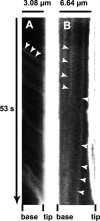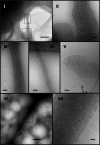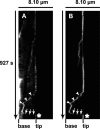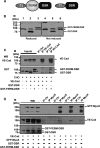The motor protein myosin-X transports VE-cadherin along filopodia to allow the formation of early endothelial cell-cell contacts
- PMID: 20123970
- PMCID: PMC2838073
- DOI: 10.1128/MCB.01226-09
The motor protein myosin-X transports VE-cadherin along filopodia to allow the formation of early endothelial cell-cell contacts
Abstract
Vascular endothelium (VE), the monolayer of endothelial cells that lines the vascular tree, undergoes damage at the basis of some vascular diseases. Its integrity is maintained by VE-cadherin, an adhesive receptor localized at cell-cell junctions. Here, we show that VE-cadherin is also located at the tip and along filopodia in sparse or subconfluent endothelial cells. We observed that VE-cadherin navigates along intrafilopodial actin filaments. We found that the actin motor protein myosin-X is colocalized and moves synchronously with filopodial VE-cadherin. Immunoprecipitation and pulldown assays confirmed that myosin-X is directly associated with the VE-cadherin complex. Furthermore, expression of a dominant-negative mutant of myosin-X revealed that myosin-X is required for VE-cadherin export to cell edges and filopodia. These features indicate that myosin-X establishes a link between the actin cytoskeleton and VE-cadherin, thereby allowing VE-cadherin transportation along intrafilopodial actin cables. In conclusion, we propose that VE-cadherin trafficking along filopodia using myosin-X motor protein is a prerequisite for cell-cell junction formation. This mechanism may have functional consequences for endothelium repair in pathological settings.
Figures















Similar articles
-
Vascular endothelial-cadherin stabilizes at cell-cell junctions by anchoring to circumferential actin bundles through alpha- and beta-catenins in cyclic AMP-Epac-Rap1 signal-activated endothelial cells.Mol Biol Cell. 2010 Feb 15;21(4):584-96. doi: 10.1091/mbc.e09-07-0580. Epub 2009 Dec 23. Mol Biol Cell. 2010. PMID: 20032304 Free PMC article.
-
ARP2/3-mediated junction-associated lamellipodia control VE-cadherin-based cell junction dynamics and maintain monolayer integrity.Mol Biol Cell. 2014 Jan;25(2):245-56. doi: 10.1091/mbc.E13-07-0404. Epub 2013 Nov 13. Mol Biol Cell. 2014. PMID: 24227887 Free PMC article.
-
Polarized actin and VE-cadherin dynamics regulate junctional remodelling and cell migration during sprouting angiogenesis.Nat Commun. 2017 Dec 20;8(1):2210. doi: 10.1038/s41467-017-02373-8. Nat Commun. 2017. PMID: 29263363 Free PMC article.
-
Dynamics between actin and the VE-cadherin/catenin complex: novel aspects of the ARP2/3 complex in regulation of endothelial junctions.Cell Adh Migr. 2014;8(2):125-35. doi: 10.4161/cam.28243. Cell Adh Migr. 2014. PMID: 24621569 Free PMC article. Review.
-
Dynamic Regulation of Vascular Permeability by Vascular Endothelial Cadherin-Mediated Endothelial Cell-Cell Junctions.J Nippon Med Sch. 2017;84(4):148-159. doi: 10.1272/jnms.84.148. J Nippon Med Sch. 2017. PMID: 28978894 Review.
Cited by
-
Myosin-1c regulates the dynamic stability of E-cadherin-based cell-cell contacts in polarized Madin-Darby canine kidney cells.Mol Biol Cell. 2013 Sep;24(18):2820-33. doi: 10.1091/mbc.E12-12-0884. Epub 2013 Jul 17. Mol Biol Cell. 2013. PMID: 23864705 Free PMC article.
-
Regulation of blood vessel sprouting.Semin Cell Dev Biol. 2011 Dec;22(9):1005-11. doi: 10.1016/j.semcdb.2011.10.006. Epub 2011 Oct 14. Semin Cell Dev Biol. 2011. PMID: 22020130 Free PMC article. Review.
-
A peptide interfering with the dimerization of oncogenic KITENIN protein and its stability suppresses colorectal tumour progression.Clin Transl Med. 2022 Jul;12(7):e871. doi: 10.1002/ctm2.871. Clin Transl Med. 2022. PMID: 35853101 Free PMC article.
-
Tissue organization by cadherin adhesion molecules: dynamic molecular and cellular mechanisms of morphogenetic regulation.Physiol Rev. 2011 Apr;91(2):691-731. doi: 10.1152/physrev.00004.2010. Physiol Rev. 2011. PMID: 21527735 Free PMC article. Review.
-
The cytoskeletal mechanisms of cell-cell junction formation in endothelial cells.Mol Biol Cell. 2012 Jan;23(2):310-23. doi: 10.1091/mbc.E11-08-0719. Epub 2011 Nov 16. Mol Biol Cell. 2012. PMID: 22090347 Free PMC article.
References
-
- Berg, J. S., and R. E. Cheney. 2002. Myosin-X is an unconventional myosin that undergoes intrafilopodial motility. Nat. Cell Biol. 4:246-250. - PubMed
Publication types
MeSH terms
Substances
LinkOut - more resources
Full Text Sources
Miscellaneous
